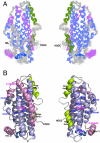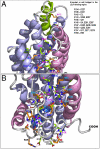Topology of human apolipoprotein E3 uniquely regulates its diverse biological functions
- PMID: 21873229
- PMCID: PMC3169138
- DOI: 10.1073/pnas.1106420108
Topology of human apolipoprotein E3 uniquely regulates its diverse biological functions
Abstract
Human apolipoprotein E (apoE) is one of the major determinants in lipid transport, playing a critical role in atherosclerosis and other diseases. Binding to lipid and heparan sulfate proteoglycans (HSPG) induces apoE to adopt active conformations for binding to low-density lipoprotein receptor (LDLR) family. ApoE also interacts with beta amyloid peptide, manifests critical isoform-specific effects on Alzheimer's disease. Despite the importance of apoE in these major human diseases, the fundamental questions of how apoE adjusts its structure upon binding to regulate its diverse functions remain unsolved. We report the NMR structure of apoE3, displaying a unique topology of three structural domains. The C-terminal domain presents a large exposed hydrophobic surface that likely initiates interactions with lipids, HSPG, and beta amyloid peptides. The unique topology precisely regulates apoE tertiary structure to permit only one possible conformational adaptation upon binding and provides a double security in preventing lipid-free and partially-lipidated apoE from premature binding to apoE receptors during receptor biogenesis. This topology further ensures the optimal receptor-binding activity by the fully lipidated apoE during lipoprotein transport in circulation and in the brain. These findings provide a structural framework for understanding the structural basis of the diverse functions of this important protein in human diseases.
Conflict of interest statement
The authors declare no conflict of interest.
Figures




Similar articles
-
A monomeric, biologically active, full-length human apolipoprotein E.Biochemistry. 2007 Sep 18;46(37):10722-32. doi: 10.1021/bi700672v. Epub 2007 Aug 23. Biochemistry. 2007. PMID: 17715945
-
The receptor binding domain of apolipoprotein E is responsible for its antioxidant activity.Biochemistry. 2005 May 24;44(20):7577-82. doi: 10.1021/bi0472696. Biochemistry. 2005. PMID: 15896001
-
Molecular mechanism of apolipoprotein E binding to lipoprotein particles.Biochemistry. 2009 Apr 7;48(13):3025-32. doi: 10.1021/bi9000694. Biochemistry. 2009. PMID: 19209940 Free PMC article.
-
Apolipoprotein E in lipoprotein metabolism, health and cardiovascular disease.Pathology. 2019 Feb;51(2):165-176. doi: 10.1016/j.pathol.2018.11.002. Epub 2018 Dec 28. Pathology. 2019. PMID: 30598326 Review.
-
Apolipoprotein E and apolipoprotein E receptors: normal biology and roles in Alzheimer disease.Cold Spring Harb Perspect Med. 2012 Mar;2(3):a006312. doi: 10.1101/cshperspect.a006312. Cold Spring Harb Perspect Med. 2012. PMID: 22393530 Free PMC article. Review.
Cited by
-
Fluorescence analysis of the lipid binding-induced conformational change of apolipoprotein E4.Biochemistry. 2012 Jul 17;51(28):5580-8. doi: 10.1021/bi300672s. Epub 2012 Jul 3. Biochemistry. 2012. PMID: 22730894 Free PMC article.
-
Lipoproteins in the Central Nervous System: From Biology to Pathobiology.Annu Rev Biochem. 2022 Jun 21;91:731-759. doi: 10.1146/annurev-biochem-032620-104801. Epub 2022 Mar 18. Annu Rev Biochem. 2022. PMID: 35303786 Free PMC article. Review.
-
Thermodynamic destabilization and aggregation propensity as the mechanism behind the association of apoE3 mutants and lipoprotein glomerulopathy.J Lipid Res. 2018 Dec;59(12):2339-2348. doi: 10.1194/jlr.M088732. Epub 2018 Oct 11. J Lipid Res. 2018. PMID: 30309894 Free PMC article.
-
Structural basis for mitoguardin-2 mediated lipid transport at ER-mitochondrial membrane contact sites.Nat Commun. 2022 Jun 28;13(1):3702. doi: 10.1038/s41467-022-31462-6. Nat Commun. 2022. PMID: 35764626 Free PMC article.
-
Native Mass Spectrometry, Ion Mobility, Electron-Capture Dissociation, and Modeling Provide Structural Information for Gas-Phase Apolipoprotein E Oligomers.J Am Soc Mass Spectrom. 2019 May;30(5):876-885. doi: 10.1007/s13361-019-02148-z. Epub 2019 Mar 18. J Am Soc Mass Spectrom. 2019. PMID: 30887458 Free PMC article.
References
-
- Weisgraber KH. Apolipoprotein E: structure-function relationships. Adv Protein Chem. 1994;45:249–302. - PubMed
-
- Mahley RW, Ji ZS. Remnant lipoprotein metabolism: key pathways involving cell-surface heparan sulfate proteoglycans and apolipoprotein E. J Lipid Res. 1999;40:1–16. - PubMed
-
- Luc G, et al. Impact of apolipoprotein E polymorphism on lipoproteins and risk of myocardial infarction. The ECTIM Study. Arterioscler Thromb. 1994;14:1412–1419. - PubMed
-
- Mahley RW, Rall SC Jr, editors. The Metabolic and Molecular Base of Inherited Disease. 8 Ed. New York: (McGraw-Hill); 2001. pp. 2835–2862.
Publication types
MeSH terms
Substances
Associated data
- Actions
Grants and funding
LinkOut - more resources
Full Text Sources
Other Literature Sources
Miscellaneous

